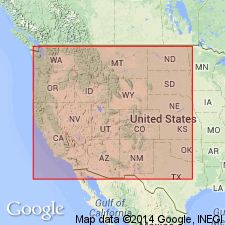
- Usage in publication:
-
- Rocky Canyon granite
- Modifications:
-
- Original reference
- Dominant lithology:
-
- Granitoid rock
- AAPG geologic province:
-
- Great Basin province
Summary:
Pg. 41. Rocky Canyon granite. White to gray granitoid rock, spotted with many flakes of biotite and in places containing biotite segregations and bunches. Frequently weathers to coarse arkosic gravel. Outcrops over 6+/- sq mi in lower Rocky and Wright's Canyons, and elsewhere, Humboldt Range, northwestern Nevada. Last of major intrusives of region. Called pre-Cambrian by 40th Parallel Survey, but Louderback has shown it is post-Triassic intrusive, and probably of Jurassic-Cretaceous age.
Source: US geologic names lexicon (USGS Bull. 896, p. 1835).

- Usage in publication:
-
- Rocky Canyon pluton*
- Modifications:
-
- Geochronologic dating
- AAPG geologic province:
-
- Great Basin province
Summary:
Pg. 21, geologic time scale (inside front cover). Rocky Canyon pluton. Quartz monzonite sample from Humboldt Range, Lat. 40 deg. 23 min. 18 sec. N., Long. 118 deg. 13 min. 54 sec. W., Unionville quadrangle, Pershing County, Nevada, yielded a K-Ar age of 73.1 +/-3.1 Ma (biotite). Age may have been reduced by later igneous activity; pluton probably emplaced in Jurassic time. Age calculated using decay constants of Steiger and Jager, 1977 (Earth Planet. Sci. Letters, v. 36, p. 359-362).
Source: Publication.
For more information, please contact Nancy Stamm, Geologic Names Committee Secretary.
Asterisk (*) indicates published by U.S. Geological Survey authors.
"No current usage" (†) implies that a name has been abandoned or has fallen into disuse. Former usage and, if known, replacement name given in parentheses ( ).
Slash (/) indicates name conflicts with nomenclatural guidelines (CSN, 1933; ACSN, 1961, 1970; NACSN, 1983, 2005, 2021). May be explained within brackets ([ ]).

